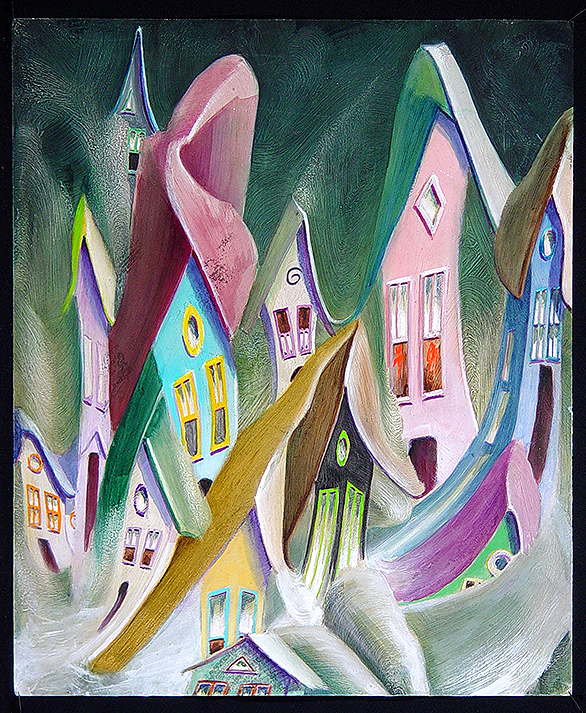Mindquake - The Real and Surreal
By: Jenny Pace - Page Two
The image of a lone house—drawn with an arched doorway, two glowing windows, a steeped roof and a chimney—has become his talisman. It recurs over and over in his work, sometimes as the focal point of a picture, sometimes as a tiny stamp of authorship in a collage. The artist traces this image’s nascent within his visual vocabulary to a once-popular test issued by psychiatrists in which subjects are asked to draw a house, a tree and a man. When he took the test as administered by a fellow student of psychology, Moses drew this, the archetypal house as rendered by a child.
His house, though, was situated high in the tree, a symbol of not only inaccessibility but one borne of an obsessive drive to ascend a higher plane of experience and observation. His house is the man, its doors and windows forming the orifices of expression. In his many considerations of this theme, as with the whole of his oeuvre, Moses’ coloration varies from the subdued grays and browns of the Dutch masters to the morose intensity of El Greco’s pinks and greens.
Moses uses color to define not just imagined scenes, but to capture the vibrations, the frenetic energy of what lies beyond the everyday, palpable if we only take a moment more to feel it. His little houses sit in a variety of environments, often braced against the swirling forces of water and air. At first glance, these images seem haunted, a sort of surrealist landscape of a childhood emblem caught up in a morbid dream of violent devastation. The house, though, becomes a stand-in for the human as we realize it delights at being riddled by the forces of nature, of the supernatural. The little house is, in fact, a part those rhythms. The swirling streams of sky and ground, as rendered in gesso, create for the viewer a tangible, nearly audible sense of the pulsations which tread just beyond and beneath our usual state of consciousness.
Here, Moses’ presence as an artist is very much apparent, made evident through the undulating, impressionistic pulses of his brush and paint strokes. His use of this technique is born of an attempt to capture the present, to make of a fleeting impression something deliberate and studied. In this way, his works become a container of meaning as they afford a view of the transcendent, a glimpse of the intangible.
Moses works in a sphere far beyond the constraints of the contemporary theory-bound, market-driven art scene. The self-fulfilling wisdom he displays is possible precisely because he is free from the sense of self-consciousness which typifies much art of the present. His artistic oeuvre, as his life, is defined by his drive to capture the second, the instant in which the atoms and molecules which make up a given image race into configuration before our eyes. His interest lies in exploring and capturing the constant re-aligning of the universe. He documents forces which range from the omnipotent, considering such primordial elements as wind and water, to the fleeting view of a smile breaking across a woman’s face.
Moses questions conventional notions of the real, and instead posits the reality of the unseen, of human memory, of the forces surging all around us. His work is, in essence, a ballad of existence as it embodies the ecstasy of both human mortality and the physicality of the inorganic. As he captures the energy of that which few acknowledge, Chris Moses creates a window onto the magic of the quotidian. Not only is his world, his vision, made apparent for the rest of us, he challenges us to take closer heed ourselves. In his whirling vortex, always, that house remains, its windows glowing for our safe return.
Back: Page One

A SUDDEN SHIFT
Acrylic and Gesso on Paper - 17 x 14
Houses
